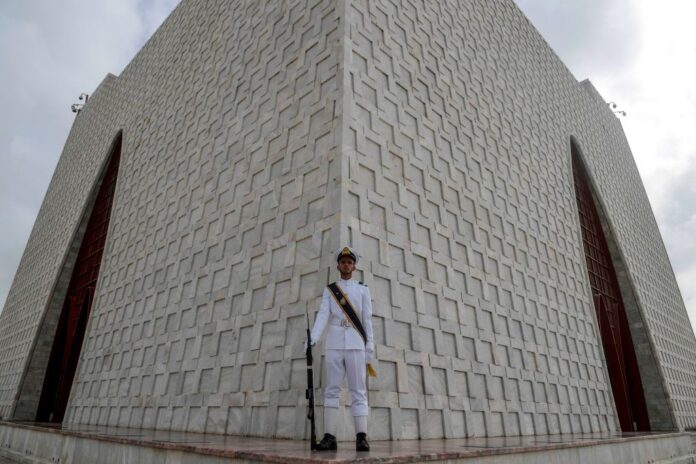KARACHI: As Pakistan celebrated 75th Independence Day on Saturday, those who participated in the movement to carve out a separate nation for Muslims recall the birth pangs and challenges to the survival of the country in the initial days.
The birth of Pakistan on the midnight of August 14, 1947, witnessed one of the world’s largest displacements, questions on its survival due to economic hardships, ragging communal riots, and the beginning of tensions with India on the dispute of Jammu and Kashmir.
According to an estimate, 6.5 million Muslims from different parts of India migrated to Pakistan, following the end of the British colonial rule.
Speaking to Anadolu Agency, Abrar Fatima, in her early 90s, recalls her family’s journey from the city of Aligarh in India to Karachi.
“For uprooted, and unsettled environment it was not easy for the migrant community to establish themselves, and their businesses easily because resources at government and corporate level were scanty,” she said.
She said migrants were out in camps everywhere in a desperate bid to find shelter.
“Locals were indeed very supportive, and helpful to look after the refugees,” she said, adding that some migrants were occupying houses, and properties left behind by the local Hindus who started to migrate to India.
Many others, who had resources bought properties from Hindus, who were migrating to India.
“When we moved to Karachi, the city had only a few hundred cars. It was a clean city of a small population with trams, and double-decker buses,” she recalled.
Further, the city was small to the extent that the mausoleum of the nation’s founding father, Mohammad Ali Jinnah, now located near the downtown, used to be in the outskirts of Karachi.
UNDERDEVELOPMENT:
Shahabuddin Haider, 91, also a resident of Karachi, had first moved to Dhaka, the capital of then East Pakistan and now Bangladesh, from the eastern Indian state of Bihar in 1952.
“There was no comparison between (then) Dhaka and Patna (provincial capital of Bihar). Dhaka was underdeveloped compared to Patna or Calcutta,” recollected Haider, who took part as a young activist in the Pakistan movement.
Sporting a white kurta-pyjama, and hunched on a sofa in the lounge of his house in central district of Karachi, Haider further said: “A few good buildings were having been constructed by the Nawabs (rulers of Dhaka), whereas a couple of thoroughfares could be taken as proper roads.”
The level of education, he said, was low even compared to West Pakistan as there were only a couple of medical and engineering colleges in entire East Pakistan at that time.
Those who owned cars at that time could be counted on fingers, he said.
The development of modern Dhaka, according to Haider, began in 1954, with the construction of infrastructure and educational institutes.
“That Dhaka was opposite to today’s glitzy Dhaka in terms of infrastructure development,” he said.
Karachi and Lahore were comparatively better in terms of infrastructure at the time of independence but were facing a flood of migrants.
Among the numerous tales of bloodshed and mass killings at the time of partition, Qamar Ahmad, a former BBC cricket commentator and senior sports journalist, has a pleasant account to share.
He and his family were saved by their Hindu neighbours during communal riots in Bihar, commonly known as “Bihar carnage” due to massive casualties.
With British colonial rule of India heading towards its end in the mid-1940s, unrest between the Hindu and Muslim communities also grew, leading Muslims to demand a separate nation.
WORST COMMUNAL RIOTS:
According to Raza Kazimi, a Karachi-based historian, the worst communal riots took place in Calcutta in August 1946 and Bihar in October 1946, in which hundreds of thousands of people, mainly Muslims lost their lives.
Days after, he added, violence erupted in the Noakhali district-now in Bangladesh, which also claimed thousands of lives, mainly Hindus.
Like many other historians, Richard Lambert in his book Hindu Muslim Riots has documented vivid details of the carnage.
Ahmad was nine years old when his home was attacked by an infuriated mob, which was looking for his father, a local Muslim League leader in Chapra city of Bihar in October 1946.
The fearful family took refuge in the house of Hindu neighbours, who saved their lives.
“My family was saved by our Hindu neighbours, a family of doctors like my father was,” Ahmad recalled while speaking to Anadolu Agency.
“They sheltered, and protected us from the mobsters for a month before calm was restored in my hometown,” he added.
REVISITING BIRTHPLACE:
Ten months later, following the creation of Pakistan, Ahmad’s family like millions of others decide to migrate to the newborn country and settled in Karachi.
“It was not that Karachi, which you see today. It was clean and less populated but in terms of economy and infrastructure there is no match with today’s metropolis,” said Ahmad, a former cricketer-turned-sports reporter.
“Rome was not built in a day. Pakistan gradually started to stand on its feet with all the struggle to go with it in early years,” he said.
Ahmed said those were traumatic times, but the role of the Hindu neighbour, who saved his family has rejuvenated his trust in humanity. Therefore, his quest to see his Hindu saviours never ceased. Finally, 30 years after partition, while accompanying Pakistan’s cricket team, he visited his place of birth
“To my surprise, my house had become a hotel where I stayed and was greeted by my Hindu neighbors. Emotions flowed, which cannot be described,” he said.
























It is time to observe 14th August with Modi as “Partition Horrors Remembrance Day”. 🤔